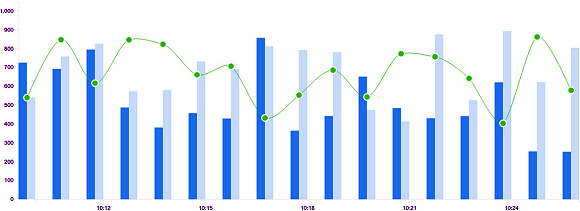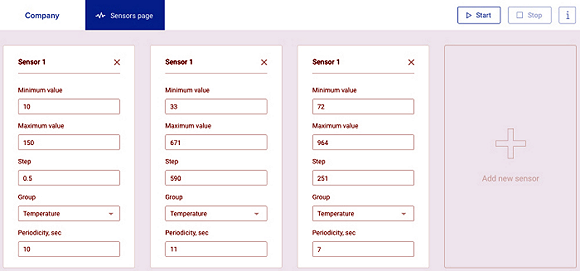
Almost any business is all about balancing at the edge of two opposite tendencies. The intention to reduce costs is one of the keystones that everybody should keep in mind while making decisions. On the other hand, it's pretty important to follow the cutting-edge technologies if the loss of competitiveness is not included in your plans.
In the case of enterprises that deal with sensors, detectors, and analytical equipment we can often face the issue of using software that was developed at the phase of equipment assembling and was not updated since then. Even if the equipment works fine, the problem with outdated software still exists and can lead to different inconveniences such as security risks. Solving this problem may become a sensitive blow to the budget. A possible solution is using online data visualization applications. Such approach allows reducing development and maintenance costs and provides a user with access from anywhere.
How Outdated Software Can Harm Your Business
1. Vulnerability
The most obvious reason for keeping the enterprise software up to date is the risk of vulnerability to viruses, spyware and hacker attacks. The legacy software was developed quite a long time ago which means that it's not prepared for today's security issues. Software complexity leads to the inevitability of existing security flaws that can cause data leaks which can be a total disaster if you work with sensitive data. It's hard to predict, what part of your application platform will become a potential source of troubles. It can be your SQL server, or FTP server, or any other software that listens the network.
2. Lack Of Support And Maintenance
The older software you use, the harder to continue updating it due to lack of the appropriate IT specialists which is particularly important if you plan to move your enterprise abroad. Moreover, tons of legacy code can become a complete mess with time making it harder to determine the source of your troubles.
3. User Experience Issues
Back in the days when the outdated software that you probably use was developed, not much attention has been paid to the user experience. Especially in the case of enterprise software. Thus, we can face cumbersome and inconvenient user interfaces. It's difficult to collect and analyze the information on how the employees interact with this software since such mechanisms were not foreseen initially. Even if we know what should be changed, making changes may be a pretty laborious and costly task.
Next page
Why Prefer Online Applications
1. Fast Development And Deployment
When you create an online application, there's no need to worry about the platform specific issues that you should take care of while developing a native desktop application. Online applications visualize your data, and every device that can run a modern browser can get access to the results of this work.
Moreover, you should not forget that it's not enough to design and develop a desktop application. Its deployment will take a significant amount of time and resources. Using cloud-based solutions, you can get together all your data assets "under one roof" which simplifies access and leads to quicker implementation.
2. Live Update
You should remember about the possibility of the centralized update. Once the application is updated on the server, all users can use the newer version of it. You can be sure that nobody uses the outdated version of your software, so there are no security and compatibility issues. Contrariwise, updating the software that is already installed on your every device may cause delays in work.
3. A Better Understanding Of UX Issues And The Possibility To Fix Them With Ease
It's easier to understand how users interact with the application. Using this information, you can quickly solve usability issues and reassess the existing features.
4. Multi-Platform Support
It's cheaper to develop an application that works on different platforms and on different mobile devices. If you use different operation systems on the enterprise and prefer to use native apps, be prepared to bear the high cost. Nowadays web development techniques allow creating the applications that look and feel the same despite the OS you use.
5. Secure Access Worldwide
Using online applications can be pretty handy comparing to the desktop apps if you intend to grow your business. Imagine that you plan to move to another country or open a new company branch abroad. Migrating and deployment will be much easier if all your data is hosted centralized. You can use secured VPN connection to be sure that your data safe during the working process.
6. Offline Support
Since we're not always connected to the Internet, in the case of online applications some concerns may arise. How can you access your data while there are no hotspots nearby? A well-designed online application has offline support. Server side data is stored locally in your browser's cache which helps to work with data when connection to the server fails.
Next page
Online Data Visualization, Possible Solutions
There are different approaches to the creation of the online data visualization apps. If you have a team of high-qualified developers in the staff of your company, you can create the required application using your own workforce. The other option is to use the services of a software development company. Thus, here's the available options:
- Libraries for developers
- Ready-made customizable solution
Let's take a look at possible options.
Libraries For Developers
There's a wide variety of frameworks that use JavaScript, HTML5, CSS3, SVG, and other modern technologies for creating such apps. You can use open-source libraries if you want to decrease the cost of development. But keep in mind that this option requires the significant amount of time and people resources.
One of the most famous of such frameworks is D3.js, High Charts, and Webix Charts. You can create almost any type of data visualization using this framework. Charts, diagrams, static, and interactive ones. It's free and open-source, so there're almost no limits of using.

On the other hand, it has a steep learning curve, and there are no pre-build charts. Thus, you should have enough time resources if you choose this tool. But it worth it. You can check the D3 gallery to make sure that the results look pretty good.
Ready-Made Customizable Solution
If there are no resources in your company to develop your own software, but you want to get a high-performance application with wide customization capabilities, you should probably choose the software development company. In this case, you can concentrate on the business itself. There's no need for you to worry about the suitable stack of technologies, data storage issues, etc.
Developers will realize all requirements and make changes in the case of need. As an example, you can take a look at SensGraph, an online data visualization prototype for remote monitoring systems. The prototype allows visualizing data from a database of a pre-configured and user-customized set of equipment or sensors. You can group sensors according to different parameters. You can view data, create alerts, and generate reports in PDF and Excel format.

Conclusions
Using online visualization tools instead of desktop apps can help you avoid some unpleasant issues. First of all, it's much easier to keep such software up to date. After the application is updated on the server, all users can get access to its fresh version. There's no need to mess with every device in your company. All that you need to get access to the required functionality is a device that has a network connection. Users can use web application from all around the world, so there's nothing to worry about if you plan to move your business to another country or create a new company branch abroad.
About the Author
Vitaly Hornik started as an IT developer almost 20 years ago and has achieved the position of the Head of Outsourcing Department at XB Software. During that period he developed and managed dozens of software projects for customers all over the world and obtained Ph.D. in IT and PMP degrees. Currently, he manages the most valuable company project and is in charge of all outsourcing projects at XB Software. Under Vitaly's responsiblity the Outsourcing department was initiated, formed and built. Nowadays it is a robust department involving professionals able to perform any type of project from scratch. Company link: http://xbsoftware.com.